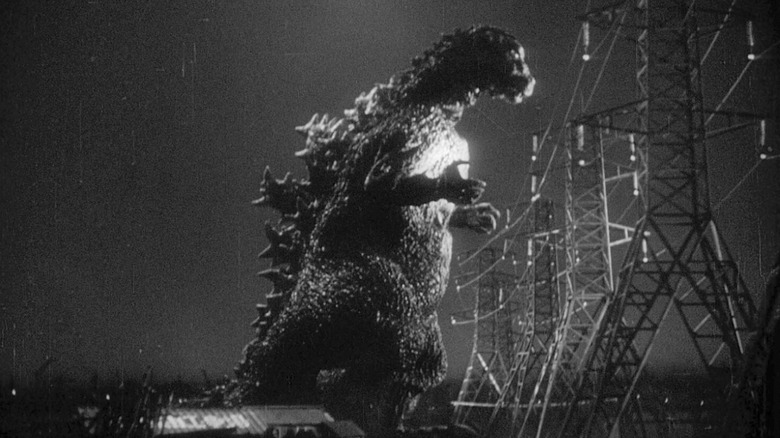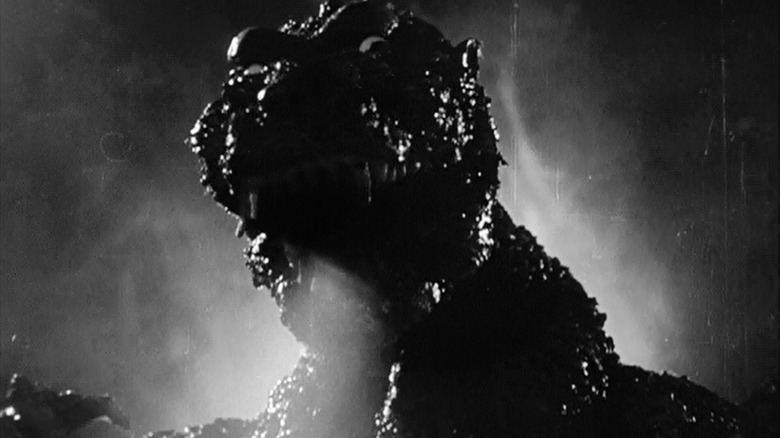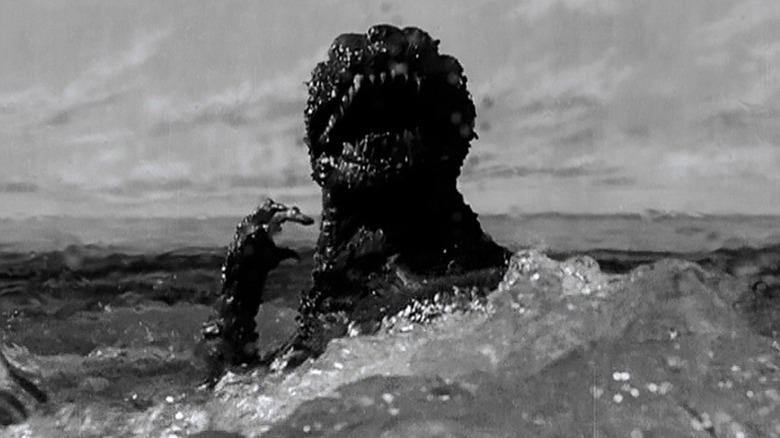The Legendary 'Lightbulb' Moment That (Maybe) Gave Birth To Godzilla
When the monster was invented in 1954, Godzilla stood as a symbol of nuclear devastation. Indeed, in March of 1954, shortly before Ishiro Honda's film "Gojira" was made, a group of fishermen aboard the ship Daigo Fukuryu Maru was exposed to radiation from a nearby American nuclear bomb test in the Bikini Atoll. One of the fishermen died of radiation poisoning and their fish were irradiated, causing a public panic about the safety of their food and the effects nuclear fallout may be having on the local fauna. As all cineastes know, Godzilla was an animal mutated by nuclear tests, turning into a nuclear-powered, unstoppable force of destruction. Godzilla echoed the devastation of the nuclear bomb that Japan had suffered at the hands of America. Honda's original "Gojira" is a somber and downbeat film about how weapons of mass destruction will never be done destroying us.
In the years since Godzilla's underlying meaning has changed several times. In the later films of the Heisei era, the Japanese government went back in time to prevent the creation of Godzilla, only to later deliberately create a new Godzilla, made to fight King Ghidorah. Godzilla was now a symbol of Japanese pride and military might.
The original "Gojira" was produced by Tomoyuki Tanaka, and written by Honda and his co-screenwriter Takeo Murata. Sadly, it's a little unclear as to which of these people initially had the idea for Godzilla, thanks to a story that Tanaka told in the 2004 "Godzilla on My Mind: Fifty Years of the King of Monsters" by William Tsutsui. By Tanaka's telling, Godzilla was all his idea, and it came to him after a crisis at Toho. It seems that a high-profile production had fallen through and he needed a new film fast.
Shadow of Honor
As Tanaka tells it (as related by Tsutsui), he was working on an expensive Toho production called "Shadow of Honor." According to the Asia-Pacific Journal, "Shadow of Honor" was an ambitious co-production between Japan and Indonesia, and was to be about a Japanese soldier who stayed in Indonesia after the end of World War II to participate in the Indonesian uprising. It seems, however, that the production fell through when real-life diplomacy broke down between Japan and Indonesia in the mid-1950s. This left producer Tanaka with a big empty hole in the Toho production schedule and a huge sum of money allocated for a film that didn't seem to be happening anymore.
Also worth noting is that Merian C. Cooper's and Ernest B. Schoedsack's 1933 hit "King Kong" had just been re-released for its 20th anniversary, and it proved to be a big hit in Japan. Tanaka seemed to intuit that effects-based outsized animal films were an invitation to large box office receipts. Giant monsters were also cropping up in the United States, as with the 1953 film "The Beast from 20,000 Fathoms."
So when Tanaka was flying back to Japan from an ill-fated meeting in Indonesia to discuss the falling apart of "Shadow of Honor," he claims to have had an "Eureka!" moment. When looking down from the plane on the islands below, and pondering the Bikini Atoll and the giant monsters in America, he began thinking (and later said):
"The thesis was very simple. [...] What if a dinosaur sleeping in the Southern Hemisphere had been awakened and transformed into a giant by the Bomb? What if it attacked Tokyo?"
Godzilla was, it seems, born at that moment.
But what's the true story?
According to Tsutsui's book, Tanaka's story is contestable. Did the producer really have a flash of inspiration, wherein Godzilla arrived in his mind fully formed? Or was the film's creation a little more pedestrian, born from economic necessity and cinema trends? It's more likely the latter. In the biography "Ishiro Honda: A Life in Film, from Godzilla to Kurosawa," it was written that several directors passed on making "Gojira" because they felt the idea was pretty dumb; it was, after all, a silly monster film about a giant gorilla-whale stomping on cities. Honda was brought on board because he felt he could take the material seriously, and lean into the film's intended anti-war and anti-nuclear themes.
And indeed, the original "Gojira," while kicking off a film franchise that would last for 70 years, wasn't necessarily well-received. When the original 1954 cut was finally released in the United States (it had previously only been available in a severely re-cut version called "Godzilla, King of the Monsters!"), Roger Ebert only gave it one-and-a-half stars, feeling that the messaging was solid, but the filmmaking was cheap and hokey. Reviews from 1954 weren't wholly kind either, with many Japanese critics giving negative reviews. Despite this, the film was a modest hit, and sequels started to infiltrate the 1960s in a big way.
The "bolt from the blue" moment that Tanaka describes sounds suspiciously like an embellishment or a cute anecdote invented after "Godzilla" was already a hit. Regardless, "Gojira" was indeed a hit, and Takana, Honda, Murata, and scads of hardworking actors and special effects technicians created an indelible cinematic image in their giant radioactive monster. Whatever Godzilla means now, audiences still love him.


